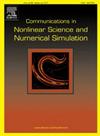An efficient computational method for simulating incompressible fluid flows on a virtual cubic surface
IF 3.4
2区 数学
Q1 MATHEMATICS, APPLIED
Communications in Nonlinear Science and Numerical Simulation
Pub Date : 2025-02-15
DOI:10.1016/j.cnsns.2025.108676
引用次数: 0
Abstract
We propose an efficient computational algorithm for simulating incompressible fluid flows on a virtual cubic surface. By neglecting the influence of gravitational force, we effectively eliminate its impact on the system. Therefore, the dynamics can be characterized as essentially two-dimensional (2D) and confined to a plane. A projection method and a finite difference method (FDM) are used to numerically solve the Navier–Stokes (NS) equations governing the fluid flow. In the projection method, we need to solve the Poisson equation for the pressure field, which is effectively solved using a multigrid method. The multigrid method is a powerful computational approach that optimizes the solution process by using a hierarchical grid structure. The multigrid method allows efficient and accurate calculations of pressure values and increases the overall simulation accuracy and performance. The effectiveness of the proposed numerical algorithm is demonstrated through computational results of the shear flow and multi-vortex problems on a virtual cubic surface. These computational results validate the reliability and efficiency of the proposed approach, and therefore demonstrate its potential to contribute significantly to the field of computational analysis in fluid dynamics on a virtual cubic surface.
求助全文
约1分钟内获得全文
求助全文
来源期刊

Communications in Nonlinear Science and Numerical Simulation
MATHEMATICS, APPLIED-MATHEMATICS, INTERDISCIPLINARY APPLICATIONS
CiteScore
6.80
自引率
7.70%
发文量
378
审稿时长
78 days
期刊介绍:
The journal publishes original research findings on experimental observation, mathematical modeling, theoretical analysis and numerical simulation, for more accurate description, better prediction or novel application, of nonlinear phenomena in science and engineering. It offers a venue for researchers to make rapid exchange of ideas and techniques in nonlinear science and complexity.
The submission of manuscripts with cross-disciplinary approaches in nonlinear science and complexity is particularly encouraged.
Topics of interest:
Nonlinear differential or delay equations, Lie group analysis and asymptotic methods, Discontinuous systems, Fractals, Fractional calculus and dynamics, Nonlinear effects in quantum mechanics, Nonlinear stochastic processes, Experimental nonlinear science, Time-series and signal analysis, Computational methods and simulations in nonlinear science and engineering, Control of dynamical systems, Synchronization, Lyapunov analysis, High-dimensional chaos and turbulence, Chaos in Hamiltonian systems, Integrable systems and solitons, Collective behavior in many-body systems, Biological physics and networks, Nonlinear mechanical systems, Complex systems and complexity.
No length limitation for contributions is set, but only concisely written manuscripts are published. Brief papers are published on the basis of Rapid Communications. Discussions of previously published papers are welcome.
 求助内容:
求助内容: 应助结果提醒方式:
应助结果提醒方式:


